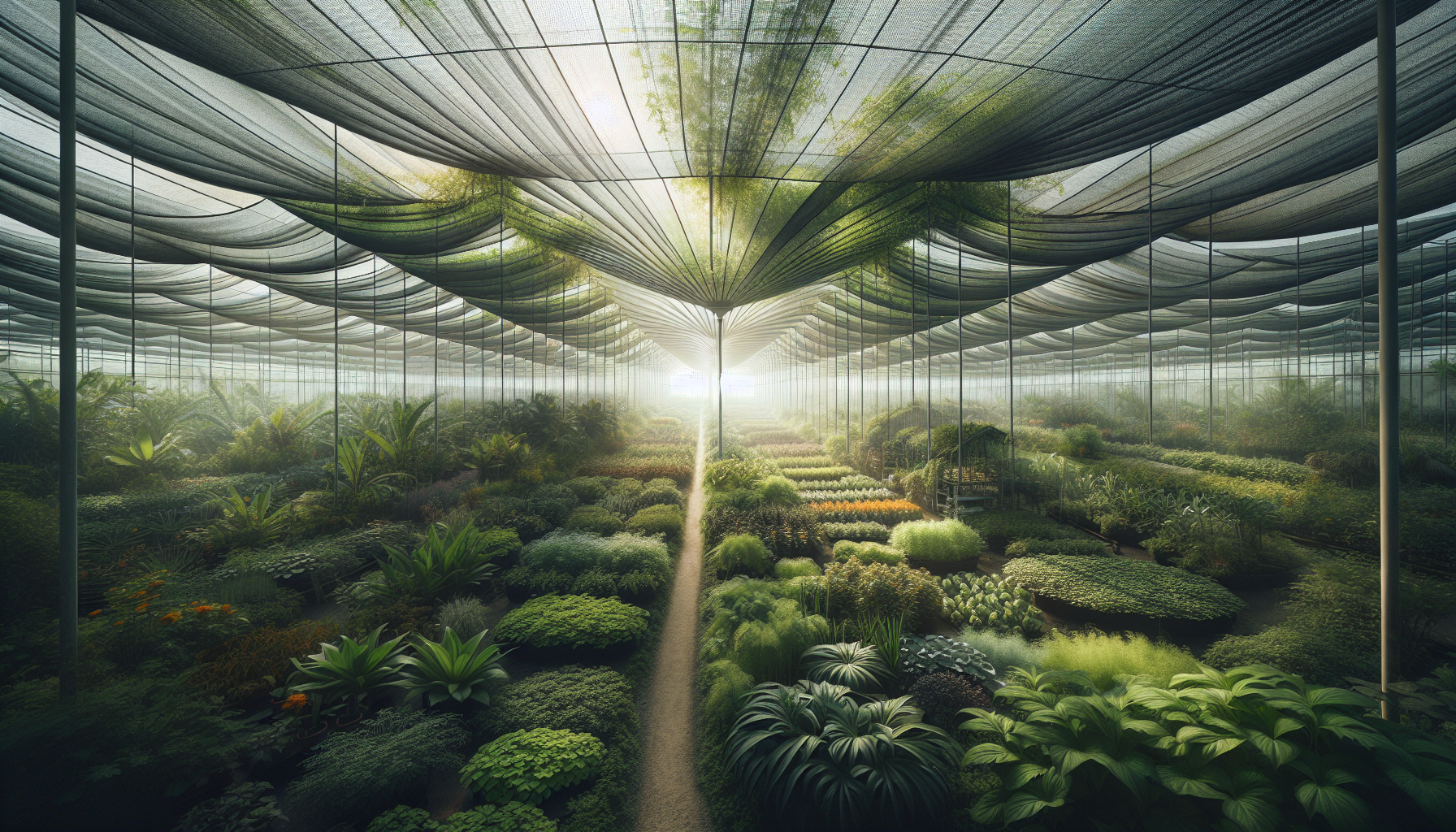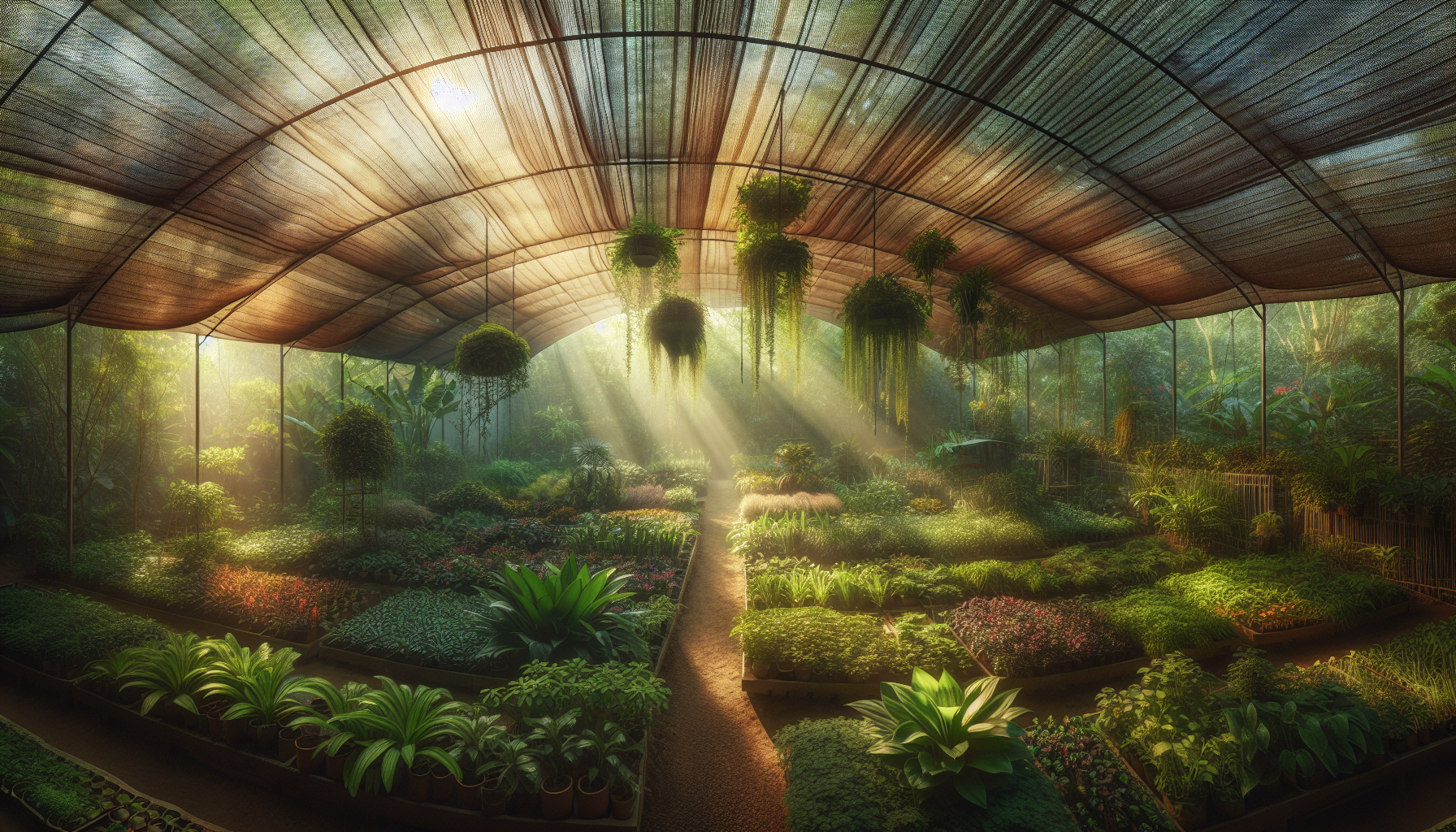
Are you an enthusiastic gardener? If so, this ultimate guide to using a shade cloth for greenhouse gardening is for you. Packed with beneficial advice and tips, the article is focused on helping you understand the significance of a shade cloth, how to select one that’s right for your greenhouse, and how to put it to appropriate use. Tending to your beloved plants will become much simpler and more effective once you have mastered the art of using a shade cloth. Get ready to start reaping the benefits of improved greenhouse gardening sooner than you can imagine.
Understanding Shade Cloth
A shade cloth is an essential tool in greenhouse gardening. It’s a simple, yet effective way to control the light, heat, and UV levels in your greenhouse.
Definition and Purpose of Shade Cloth in Greenhouse Gardarding
Shade cloth is a woven, breathable fabric used in greenhouses to protect crops from extreme sunlight and heat exposure. It’s purpose is to ensure plants receive just the right amount of sunlight they need for proper growth, while simultaneously blocking harmful UV rays and reducing internal greenhouse temperatures.
Types of Shade Cloths Available
There are numerous types of shade cloths available, each designed to meet specific gardening requirements. Some widely used types include monofilament, tape, and knitted shade cloths. Monofilament shade cloths offer durability, while tape cloths are economical but less durable. Knitted shade cloths, on the other hand, blend longevity with easy handling.
Pros and Cons of Using Shade Cloth
Shade cloths offer many benefits, such as protecting plants from harsh sunlight, regulating greenhouse temperatures, and reducing water evaporation. However, improper use can lead to insufficient light for plant growth, uneven shading leading to inconsistent plant development, and potential difficulty in installation and maintenance.
The Science Behind Shade Cloth
Understanding the science behind shade cloths can help optimize their use for greenhouse gardening.
How Shade Cloth Affects Plant Growth
Shade cloths impact plant growth by regulating light, temperature, and moisture. Different plants require different levels of shade, for example, vegetables need full sun, while ferns thrive in the shade. Shade cloths can help adjust these conditions to suit the specific needs of your crops.
Photosynthesis and Light Diffusion
Shade cloths help diffuse sunlight so that it is evenly distributed across all the plants. Even light distribution ensures fair photosynthesis rates amongst all plants, reducing competition and improving overall growth uniformly.
Temperature Regulation within the Greenhouse
By blocking some of the sun’s rays, shade cloths lower the temperature in a greenhouse, preventing plants from overheating on scorching days. Temperature regulation also helps retain water, reducing your irrigation needs and preventing your plants from wilting due to dehydration.

Selecting the Right Shade Cloth
Choosing the right shade cloth depends on several factors,
Factors to Consider When Choosing Shade Cloth
Some of these factors include your plant types, location of your greenhouse, climate, and even the age or growth stage of your plants. Knowing your plants’ sun requirement, the type of crop you’re growing or planning to grow can dictate the type and density of shade cloth you need.
Percentage of Shade: Determining the Right Density
Shade cloth density refers to the percentage of light it blocks out. A shade cloth with a high density, such as 80%, blocks out more sunlight, making it suitable for delicate plants needing less sunlight. Lower density cloths let in more sunlight, ideal for sun-loving plants.
Material Choices: Reflective vs. Absorptive Cloths
Reflective cloths bounce the sun’s rays away from the greenhouse, while absorptive ones trap heat. Depending on the climate in your region, you may opt for a reflective or absorptive cloth, or a mix of the two to balance the cooling effect in summers and heat retention in winters.
Installation of Shade Cloth
Installing a shade cloth may seem daunting, but with the correct tools and instructions, it can be an easy DIY project.
Tools Needed for Installing Shade Cloth
All you need are some clamps or clips to secure the cloth, a measuring tape for accurate fitting, scissors for cutting excess, and a ladder to reach the top of the greenhouse.
Step-by-Step Installation Guide
Installation starts by measuring, cutting, and fastening the cloth over your greenhouse, usually over the roof and the sides. Ensure it is thoroughly secure and can withstand winds.
Maintaining Proper Airflow with Shade Cloth Installation
While securing the shade cloth, take care to allow for ventilation. A well-installed shade cloth should not obstruct the greenhouse vents or fans, instead, it should allow for air circulation to prevent humidity build-up.

Seasonal Use of Shade Cloth
Using shade cloths isn’t a rigid practice; it involves adjusting according to the changing seasons.
Adjusting Shade Cloth Deployment Seasonally
In hot summers, you’ll likely need heavier shade cloths, while in spring or autumn, a lighter shade cloth may suffice. During cold winters, you might choose to remove the shade cloth altogether to allow maximum sunlight and warmth into your greenhouse.
Summer Strategies: Maximizing Cooling
In the sweltering heat of summer, using a higher density shade cloth can protect plants from heat stress. Pairing shade cloth use with adequate watering can ensure that your plants remain cool and adequately hydrated.
Winter Tactics: Balancing Light and Heat Retention
In the winter, you can use a lighter shade cloth to let in as much sunlight as possible while still protecting your plants from harsh, direct sunlight. At the same time, shade cloths help trap some warmth inside the greenhouse.
Maintenance and Care of Shade Cloth
Like other tools, shade cloths require regular maintenance and care to remain effective and increase lifespan.
Cleaning and Storage Tips for Shade Cloth
Cleaning a shade cloth involves gentle washing to remove dust, bird droppings, or any other dirt. It’s best to store your shade cloth in a dry place to prevent mildew or mold growth.
Repairing Tears and Damage
Damage to your shade cloth can happen over time due to wear and tear or harsh weather. Minor damage can often be repaired using a needle and thread or with adhesives designed for fabric repair.
Longevity: Expected Lifespan of Shade Cloth Material
With proper care, a superior quality shade cloth can last for several years. The lifespan will vary based on cloth material, exposure to harsh weather, and care.
Irrigation and Shade Cloth: Working Together
Shade cloth’s effect on temperature and light directly affects irrigation needs of the plants.
Modifying Watering Schedules with Shade Cloth Use
Since shade cloth reduces water evaporation, you can adjust your irrigation schedule to avoid overwatering. This not only conserves water but also prevents waterlogging, which can harm the plant roots.
Understanding Evapotranspiration Under Shade
Shade cloth helps maintain a balanced environment, thereby reducing the rate of evapotranspiration – a process through which water is transferred from the land to the atmosphere by evaporation from the soil and other surfaces and by transpiration from plants.
Synergizing Drip Irrigation and Shade Cloth Systems
Shade cloth works perfectly with drip irrigation systems. This combination ensures that the plants get the water they need despite the reduced evaporation rate and also reduces water wastage.
Integrating Shade Cloth with Greenhouse Technology
The use of shade cloths has evolved over time, and today, smart features allow for automatic adjustments, integrating well with greenhouse technologies.
Automated Shade Systems: Advantages and How-To
Automated shade systems can adjust shade levels based on the time of day, temperature, and other factors. Such systems can save both time and effort, and provide optimal growing conditions for plants.
Shade Cloth Compatibility with Greenhouse Vents and Fans
While installing shade cloth, care should be taken not to block the vents or fans. Correct installation ensures that the cloth works in harmony with these features to provide efficient cooling and proper air circulation.
Innovative Smart Greenhouse Features for Shade Regulation
With advancements in technology, innovative features like remote-controlled shade adjustment and climate-responsive systems are making shade cloth use more efficient and user-friendly.
Troubleshooting Common Shade Cloth Issues
Even with the best practices, some common issues may arise while using shade cloth in your greenhouse.
Identifying and Solving Insufficient Light Penetration
An easy way to identify insufficient light penetration is by observing the health of your plants. If they seem stunted or have color changes, increasing the light penetration by using a shade cloth with less density may solve the problem.
Dealing with Wind Damage and Proper Anchoring Techniques
Wind can cause significant damage to your shade cloth. Ensuring it is properly anchored and secured, especially at the edges, can mitigate this risk. Using sturdy clips, ties, and suitable framing material can help withstand wind forces.
Uniformity Problems: Ensuring Even Shade Distribution
Uneven shade distribution can lead to inconsistent plant growth. Correct cloth positioning and regular adjustments can help ensure uniform shade distribution.
Shade Cloth Beyond the Greenhouse
Shade cloth’s applications go beyond just greenhouse gardening.
Alternative Applications of Shade Cloth in Horticulture
Shade cloth can also be used in nurseries or outdoor gardens to protect young saplings. It’s an excellent tool for regulating sunlight and temperature during seed germination and early growth stages.
Adapting Shade Cloth for Outdoor Gardens and Nurseries
When adapted for outdoor use, they can serve as canopies or covers, helping to create a comfortable outdoor space during hot or rainy days. With a little creativity, you can adapt the concept of a shade cloth to a variety of uses in your outdoor nursery or garden.
Innovations and DIY Projects Using Shade Cloth
From creating shaded play areas for kids to designing cozy lounging spots in your backyard, shade cloths can be a versatile material for numerous DIY projects.
In conclusion, understanding how to use and manage shade cloth effectively can greatly impact the success of your greenhouse gardening. From helping regulate light to controlling temperature and moisture levels, a shade cloth can become your best tool in managing a productive and thriving greenhouse. So, invest your time understanding your plants, their needs, and you will unlock the potential of shade cloth in making your greenhouse gardening venture a success.

